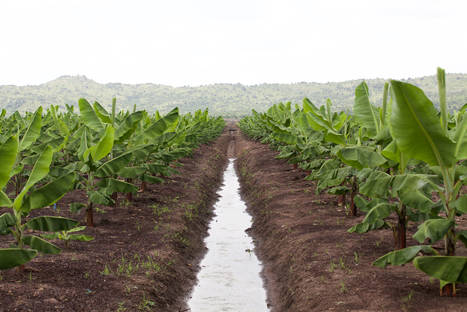As an avid gardener with years of experience cultivating tropical fruits, I’m thrilled to share my knowledge on growing banana plants. This guide will walk you through every step of the process, from selecting the right variety to harvesting your first bunch of delicious bananas. Let’s embark on this exciting journey together!
Understanding Banana Plants
Banana plants are fascinating creatures. Despite their tree-like appearance, they’re actually giant herbs related to orchids and lilies. Their “trunk” is actually a pseudostem made of tightly wrapped leaf sheaths. This unique structure allows banana plants to grow rapidly and produce fruit in as little as 9 months under ideal conditions.
Choosing the Right Variety
When it comes to banana varieties, you’re spoiled for choice. Here are some popular options:
- Cavendish: The most common commercial variety, known for its sweet flavor.
- Ladyfinger: Smaller fruits with a delicate taste.
- Red Dacca: Eye-catching red-skinned bananas with a raspberry-like flavor.
- Plantains: Starchy varieties best for cooking.
For beginners, I recommend starting with a Dwarf Cavendish. It’s hardy, compact, and produces delicious fruit.

Ideal Growing Conditions
Banana plants thrive in:
- Warm temperatures (60-80°F)
- High humidity (70-80%)
- Full sun to partial shade
- Rich, well-draining soil
- Protection from strong winds
Step-by-Step Guide to Growing Banana Plants
1. Obtaining Your Banana Plant
You can start your banana plant from:
- A sucker (offshoot) from an existing plant
- A rhizome piece
- A tissue-cultured plantlet
I’ve had the best success with suckers. They’re readily available and establish quickly.
2. Preparing the Planting Site
Choose a location that:
- Receives at least 6 hours of direct sunlight daily
- Is sheltered from strong winds
- Has well-draining soil
Prepare the soil by:
- Digging a hole twice the size of the root ball
- Mixing in plenty of organic matter (compost, well-rotted manure)
- Adding some balanced slow-release fertilizer

3. Planting Your Banana
- Gently remove the plant from its container
- Place it in the prepared hole, ensuring it’s at the same depth as it was in the pot
- Backfill with soil, firming gently
- Water thoroughly
4. Caring for Your Banana Plant
Watering:
- Keep the soil consistently moist but not waterlogged
- Water deeply once or twice a week, depending on rainfall
Fertilizing:
- Feed monthly with a balanced fertilizer high in potassium
- Apply a thick layer of organic mulch around the base
Pruning:
- Remove dead or damaged leaves
- Cut off suckers, leaving only 2-3 to ensure vigorous growth

Protection:
- In cooler climates, protect plants from frost by wrapping them in burlap or moving them indoors
5. Harvesting Your Bananas
- Bananas are ready to harvest when they’re full-sized but still green
- Cut the entire bunch and hang it in a cool, dry place to ripen
- Individual hands will ripen faster if separated from the bunch
Troubleshooting Common Issues
Pests:
- Banana weevils: Use neem oil or introduce beneficial nematodes
- Spider mites: Increase humidity and use insecticidal soap
Diseases:
- Panama disease: Plant resistant varieties and practice crop rotation
- Sigatoka leaf spot: Remove affected leaves and improve air circulation

Expert Tips for Success:
- Companion planting: Grow ginger or turmeric near your banana plants. They share similar requirements and can maximize space utilization.
- Water conservation: Install a drip irrigation system to ensure consistent moisture without waste.
- Frost protection: In cooler climates, consider growing your bananas in large containers that can be moved indoors during winter.
- Organic pest control: Introduce ladybugs to your garden to control aphids naturally.
- Soil health: Regularly test your soil pH and adjust as needed. Bananas prefer slightly acidic soil (pH 5.5-6.5).
The Environmental Impact of Growing Bananas
- Reduced carbon footprint: Home-grown bananas eliminate the need for long-distance transportation.
- Biodiversity: Your banana plant provides habitat for local wildlife.
- Soil improvement: The plant’s extensive root system helps prevent soil erosion.
- Organic growing: By avoiding chemical pesticides, you’re protecting beneficial insects and soil microorganisms.

Conclusion:
As you embark on this exciting journey of growing banana plants, remember that each day brings you closer to that moment of sweet success. The lush foliage, the emerging flower, the developing fruit – each stage is a testament to your care and dedication.
Growing bananas is more than just cultivation; it’s a connection to tropical paradises, a nod to sustainable living, and a delicious hobby that rewards you with nature’s bounty. So, roll up your sleeves, get your hands dirty, and let’s grow some bananas!
People also ask:
How long does it take for a banana plant to produce fruit?
Under ideal conditions, a banana plant can produce fruit in 9-12 months. However, it may take up to 18 months in less optimal environments.
Can I grow bananas indoors?
Yes, dwarf varieties can be grown indoors in large containers. Ensure they receive plenty of light and maintain high humidity.
Do banana plants die after fruiting?
The main stem dies after fruiting, but new suckers will grow from the rhizome to replace it.
How many bananas can I expect from one plant?
A healthy plant can produce 300-400 bananas in a single bunch.
Can I grow bananas from store-bought fruit seeds?
Most commercial bananas are seedless. It’s best to start with a sucker or tissue-cultured plant.
Read also: https://plantgrowup.com/how-to-grow-aloe-vera-plant/